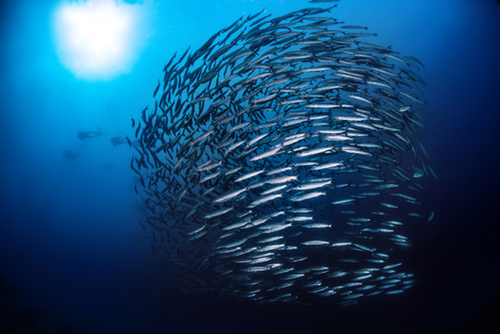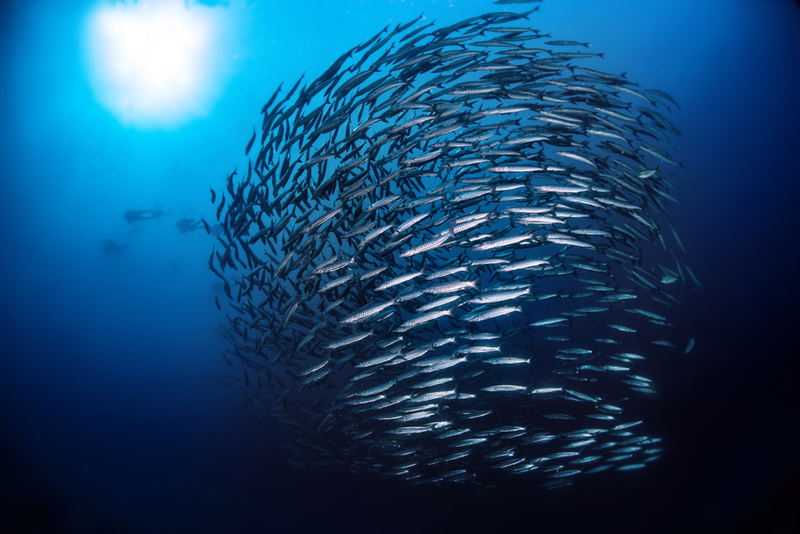Fluid Interactions Help Fish in a School Swim Faster
The collective motions of bird flocks and fish schools result from each animal responding only to the motions of its neighbors. But unlike birds, fish move through a liquid. A team of researchers has now used computer simulations to show that the flow of water induced by the fish can have a significant influence on the coordinated patterns they create. Accounting for the previously ignored fluid effects in the simulations led to fish achieving higher average swimming speeds for the same effort and to the prediction of a new collective pattern that the team hopes to observe in real fish.
Schooling of fish, displayed by about half of all known fish species, can take several forms. The group can simply swarm together without a strong degree of alignment, or the fish may swim in collectively oriented streams, balls, or rings. These motions are believed to assist in foraging and in avoiding predators. Theoretical models can reproduce much of this schooling behavior without requiring any large-scale organization; they simply assume that each fish follows some simple “local” rules, such as aligning itself with the average orientation of those nearby [1].
Fish can sense fluid flow using their lateral line—a series of small, hair-like sensory organs distributed along the sides of their bodies. And each individual can improve its efficiency by swimming in the slipstream of another fish [2]. But whether and how these hydrodynamic effects influence the collective motions of schools hasn’t been studied very much.
Christophe Eloy of the Ecole Centrale Marseille in France and his co-workers looked into the effects of fluid dynamics using virtual fish moving in two dimensions. As in previous models, the researchers assume that the fish tend to “attract” each other and to orient themselves to some extent with other fish within their field of view. They assume that the flow is smooth, so that turbulent vortices in the wake are ignored.
Under these conditions, Eloy and colleagues find that the fish show four distinct modes of collective motion, depending on the parameters of the behavioral rules: random but cohesive swarming; aligned, mostly straight-line swimming (“schooling”); swimming in a collective circle (“milling”); and rapid, aligned swimming with frequent spontaneous turns (“turning”).
The researchers compared the outcomes for groups of 100 fish both with and without hydrodynamics, plotting the results as phase diagrams of the different swimming modes. Without the fluid being modeled explicitly, the fish tend to swim in an aligned schooling state unless the strength of the alignment parameter is small—in which case they typically “mill” (swim in a collective circle). But in that latter case, if the randomness in their motion is high then they “swarm” instead.
With the fluid added, however, the turning phase appears too. What’s more, the average speed of the fish is greater with the fluid included. Eloy and colleagues say that turning arises from greater rotational randomness or noise introduced by the hydrodynamic effects. In other words, Eloy says, what could look like a consequence of behavior—the “free will” of the fish, you might say—is here actually a result of the fluid dynamics.
“I know of no previous self-organization models of collective animal behavior that have properly integrated hydrodynamics,” says Jolle Jolles of the Max Planck Institute of Ornithology in Radolfzell, Germany, who studies collective animal motion.
Mathematical biologist David Sumpter of the University of Uppsala in Sweden says that the identification of the turning phase could help to resolve the question of why fish develop curving trajectories, as in milling. “An assumption in modeling this previously is that they preferentially follow those in front of them and ignore those behind—that they have a blind angle,” he says. In other words, the asymmetry that produces curving is put in by hand to begin with. But in the new work, says Sumpter, “a circular pattern is generated by an asymmetry created by the hydrodynamics rather than a built-in asymmetry in interactions.”
Sumpter hopes that the authors will now attempt to relate their modeling results to real observations. “There is lots of available data on which they could test their ideas,” he says. The first step might be looking for the turning phase, which Eloy says has not been reported for real fish. “Our guess is that either no species lies in the correct range of parameters or this phase has been previously interpreted as schooling.
This research is published in Physical Review Letters.
–Philip Ball
Philip Ball is a freelance science writer in London. His latest book is How Life Works (Picador, 2024).
References
- I. Couzin, J. Krause, R. James, G. Ruxton, and N. Franks, “Collective Memory and Spatial Sorting in Animal Groups,” J. Theor. Biol. 218, 1 (2002).
- C. K. Hemelrijk, D. A. P. Reid, H. Hildenbrandt, and J. T. Padding, “The Increased Efficiency of Fish Swimming in a School,” Fish Fish. 16, 511 (2014).





